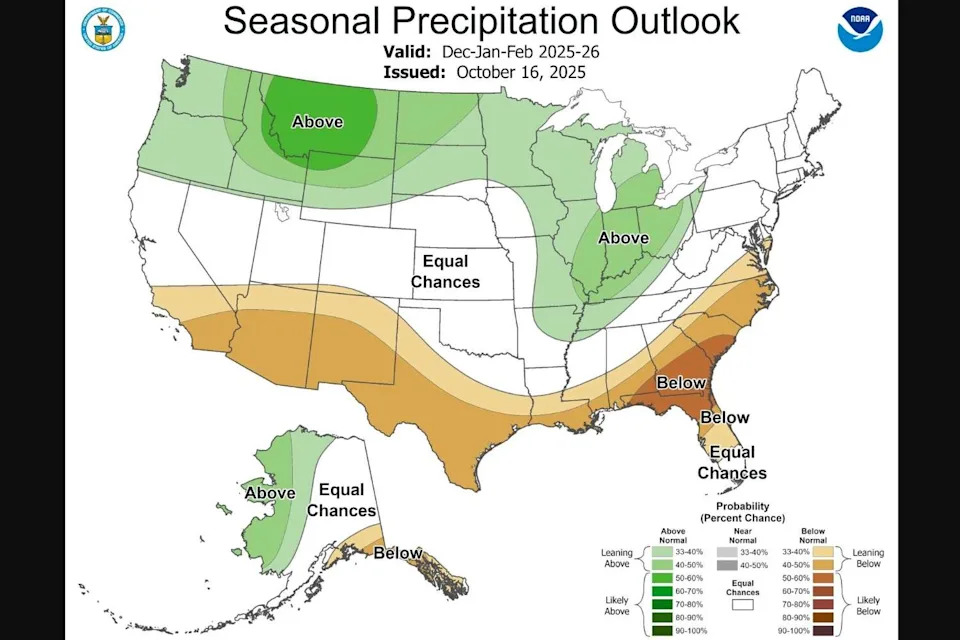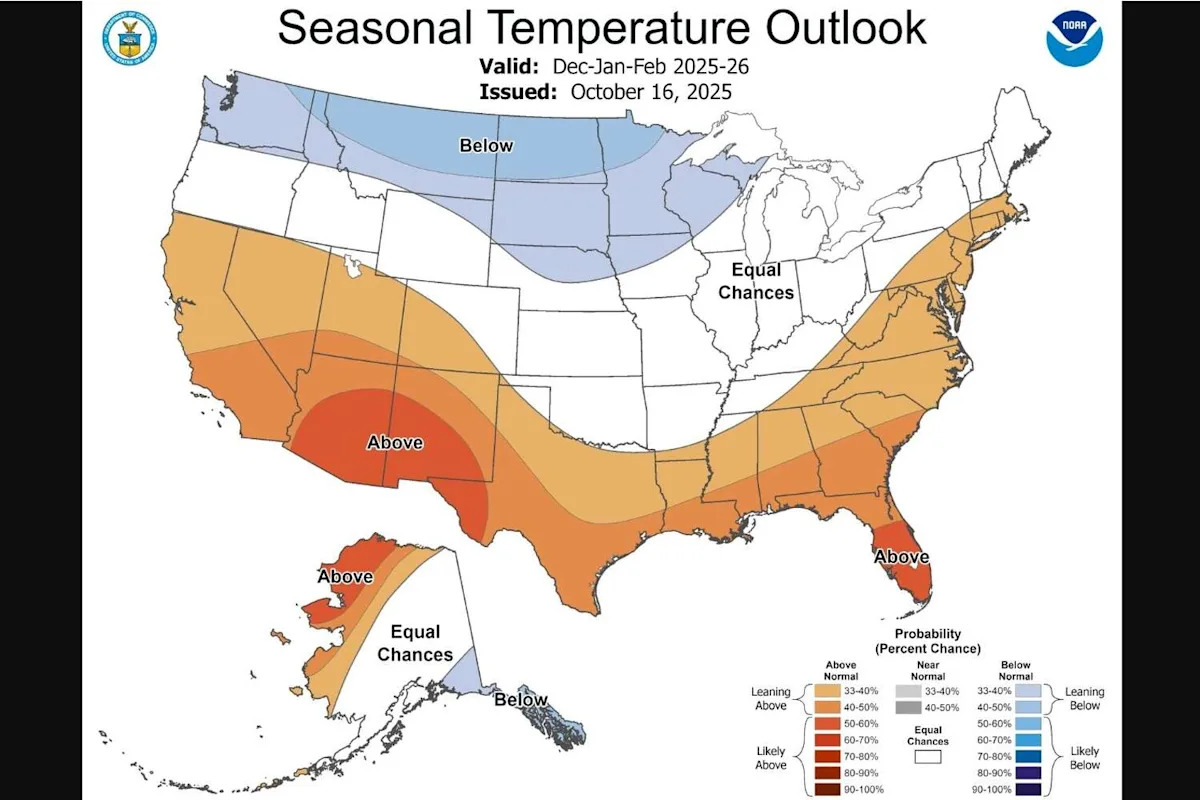Much of Texas south of the Panhandle can look forward to a warmer and drier winter than normal, according to the official winter outlook from the National Oceanic and Atmospheric Administration.
Although NOAA, the federal government parent agency of the National Weather Service, was able to release its seasonal forecast this week, the ongoing budget impasse in Congress, has delayed the annual winter briefing by the weather service’s Climate Prediction Center, a key event that meteorologists and energy producers rely on each fall.
Winter outlook
A few caveats to remember about the Climate Prediction Center’s winter outlook:
The seasonal outlook covers meteorological winter, which begins Dec. 1. Winter is defined as the calendar months of December, January and February.
The outlook also is strictly about probabilities and confidence in those likely trends, so it doesn’t include actual temperature or rainfall projections in degrees or inches.
The outlook also does not account for snowfall accumulation, and freezes can still occur in areas projected to be warmer than normal.
One of the biggest influences on the winter, according to the Climate Prediction Center, will be La Niña, which is when the equatorial waters in the eastern Pacific Ocean become cooler than average. Such a significant change in sea-surface temperatures can have global effects, including shifts in the jet stream, a river of air that drives weather patterns from west to east.
During a La Niña winter, the jet stream tends to shift more to the north, which ends up redirecting cold fronts and storms away from Texas, leaving us with warmer and drier conditions than what we would normally experience in winter.
Beyond Texas, the Climate Prediction Center favors a milder winter across the entire southern tier of the country and along the Eastern Seaboard.
That’s bad news for the lingering and intensifying Texas drought. Data released Thursday from the U.S. Drought Monitor showed severe to exceptional drought had expanded in Texas from 26.4% of land area last week to about 30% this week.
Already this fall, drought conditions have rapidly spread across Southeast Texas and are expected to worsen over the next two weeks thanks to warmer temperatures and only slim rain chances. Of all 254 Texas counties, at least 151 were under a burn ban, including Harris, Montgomery, Fort Bend, Chambers, Liberty and Waller counties.
This winter, drier conditions are expected in much of Texas and neighboring regions, including the desert Southwest and along the Gulf Coast. The Climate Prediction Center has high confidence that drought will persist and worsen from southern Texas to California.
While La Niña is known to reduce the likelihood of sustained winter chill, previous La Niña winters, like the winter of 2020-21, can still produce events like the historic February 2021 Texas freeze, proving that bitterly cold air can still reach Houston.

While wetter weather than normal is expected for the Ohio Valley and southern Great Lakes region, the desert Southwest, much of Texas and the Gulf Coast is likely to be drier than normal, according to the National Weather Service’s Climate Prediction Center. (Climate Prediction Center/National Weather Service)
Forecasts continue, but outreach suffers
While the shutdown has paused formal communications from the Climate Prediction Center, regional National Weather Service offices – including the one serving Houston and Galveston – continue issuing daily forecasts, warnings, and updates as usual. Essential meteorological operations are protected from shutdowns, but public outreach opportunities, like storm spotter training, data maintenance, and long-term data research continues to be put on hold.
These interruptions can create ripple effects for local agencies that depend on consistent federal data and briefings to prepare for winter weather, energy demand, and emergency response.
{ “__type”: “devHubFreeformEmbed”, “__id”: “Datawrapper”, “__fallbackImage”: “https://datawrapper.dwcdn.net/aR3vg/mobile.png”, “__data”: { “datawrapper_id”: “aR3vg” } }
Texans weigh the winter ahead
Although the Climate Prediction Center’s data remains online, without the detailed discussion and localized insight typically offered during the annual Winter Partners Webinar, forecasters and planners will be missing valuable context on how these national trends might unfold across Texas.
The weather service said the Winter Partners Webinar, originally slated for mid-October, has been rescheduled for Nov. 6 because of the government shutdown. If the shutdown continues long enough, the presentation could be delayed again.
JTdCJTBBJTIwJTIwJTIwJTIwJTIyX190eXBlJTIyJTNBJTIwJTIyZGV2SHViRnJlZWZvcm1FbWJlZCUyMiUyQyUwQSUwOSUyMl9faWQlMjIlM0ElMjAlMjJEYXRhd3JhcHBlciUyMiUyQyUwQSUwOSUyMl9fZmFsbGJhY2tJbWFnZSUyMiUzQSUyMCUyMmh0dHBzJTNBJTJGJTJGZGF0YXdyYXBwZXIuZHdjZG4ubmV0JTJGYVIzdmclMkZtb2JpbGUucG5nJTIyJTJDJTBBJTA5JTIyX19kYXRhJTIyJTNBJTIwJTdCJTBBJTA5JTA5JTIyZGF0YXdyYXBwZXJfaWQlMjIlM0ElMjAlMjJhUjN2ZyUyMiUwQSUwOSU3RCUwQSU3RCUwQQ==
This article originally published at Winter weather predictions for Texas have been released by NOAA. Here’s what you should expect..

